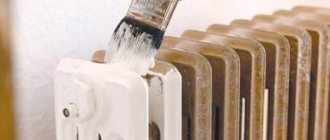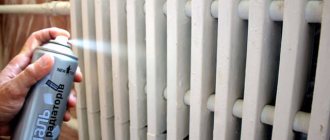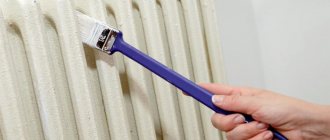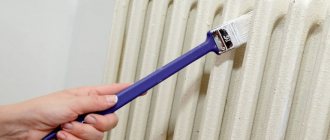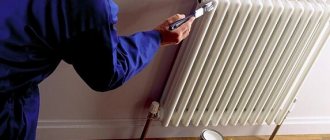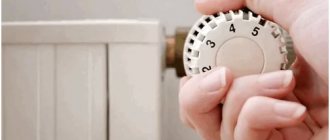Is it possible to paint hot radiators? This question worries those who were delayed in renovating their apartment in the summer and had to do it during the heating season. Paints are a product of the chemical industry and people have concerns about how a fresh paint coating will “behave” on the surface of a hot metal.
In this article, the reader will learn what risks may arise and how to avoid them when painting hot batteries. Here are tips on how to prepare a radiator for painting, what is the best way to paint it, and what type of paint to use for the heating device, depending on its type. Step-by-step instructions will help with this.
You also need to prepare paint, tools and the necessary materials, arm yourself with personal protective equipment, and only after that proceed directly to the painting itself.
Requirements for paint for hot batteries, which one to choose
Heating radiators require a special approach in choosing paint during the heating season. After all, these are devices that can get very hot in winter and not every paint is suitable for these conditions. The coloring matter needs to go through the stage of polymerization and drying on heated metal without losing properties such as adhesion, color fastness, strength and attractive appearance. In addition, the coloring material must be hypoallergenic and not emit unpleasant odors.
Taking into account the above requirements for hot batteries, the following paint materials are used:
- acrylic;
- alkyd;
- oil;
- water-based;
- special;
- enamel in aerosol.
Acrylic
Acrylic dyes, created on the basis of polyacrylic emulsions, dry quickly, are odorless, and are used for painting batteries in children's rooms . Based on the type of solvent, they can be divided into water-dispersed types and dyes based on organic solvents. To paint batteries, water-soluble acrylic compounds are used. They are environmentally friendly and harmless to human health.
One of the advantages of acrylic compositions is that fresh drips and stains in unnecessary places can be easily removed with a rag soaked in water, without leaving any traces.
At the same time, you should not leave a can of paint open even for a short time. The paint will dry quickly and lose its quality.
Alkyd
Alkyd paints are made from alkyd resins obtained by heat treatment of vegetable oils with the participation of alcohols. Alkyd compositions are sold ready-made in metal cans. They are elastic and durable, dry quickly, do not shrink, crack or lose their brightness. The most common type of alkyd paint is white pentaphthalic enamel.
A significant disadvantage of this dye is that the components of the paint evaporate when it dries and can emit an unpleasant odor for a long time.
Therefore, painting batteries in winter with an alkyd composition can be done armed with a special gas respirator, emptying the premises of people for a while, and as far as possible in winter, ventilate rooms with freshly painted radiators.
Another disadvantage is poor white color fastness. Over time, painted surfaces turn yellow.
Oily
They are based on vegetable oils. Used as waterproof coatings on metal surfaces.
Oil compositions are practically not used for painting radiators when hot.
They have been successfully replaced by acrylic dyes. Surfaces painted with oil compositions take a long time to dry, but form a durable coating that prevents the occurrence of corrosion processes in the metal of the batteries.
Water-based
They consist of water with small particles of polymers and pigments in suspension. After applying paint to any surface, water molecules evaporate, leaving a durable layer of hardened emulsion. In their composition, water-based dyes are similar to acrylic paints.
They can be used to paint hot heating appliances. Over time, paint may lose its gloss and begin to peel.
Special
These are targeted enamels, namely, specially created for painting appliances and heating pipes in any condition - be they cold, warm or very hot.
These are basically the same acrylic paints, only they contain special additives. The special paint is hypoallergenic, odorless and does not turn yellow over time. After drying, the paint coating forms a durable glossy layer.
Enamels in aerosol
Aerosol enamel is convenient when you need to paint panel radiators. You can find this product on sale in cans with automotive heat-resistant enamel. Unlike lattice cast iron batteries, panel radiators are solid planes.
For this reason, the aerosol lies almost completely on the surface being treated, without going to the side. Therefore, despite the apparent high cost of paint in cans, in the end, significant cost savings are obtained.
Having considered the above types of painting materials, you can choose paint for hot radiators during the heating period, taking into account the characteristics of heating devices.
Types of heat-resistant paints
Paint for pipes and radiators is available on different bases. These are acrylic and silicone water-dispersion compositions, alkyd enamels, oil paints.
Acrylic
The most popular are acrylic paints. They dry quickly, have virtually no odor even at the time of application, do not emit harmful substances when heated, and at the same time have an affordable price. But when purchasing them, you need to pay attention to heat resistance - for such compositions it often does not exceed 80 degrees.
A fairly thick solution is easy to apply and does not spread, forming a smooth surface without smudges, but subject to preliminary priming of the base and a two-layer coating. The texture of such compositions is matte and glossy. The main disadvantage of acrylic paints is their low resistance to abrasion and mechanical damage.
Does paint color affect the heat transfer of a radiator?
In the modern world, there is a lively debate on this matter. Moreover, there are contradictory and mutually exclusive opinions. The statements of one side agree that color can have a great influence on the heat transfer of heating devices, while other participants in the dispute, on the contrary, exclude the influence of the color of the batteries on the degree of heat transfer into the interior of the heated room.
The real answer to this question lies in the third plane.
Yes, the color of the paint can affect the heat transfer of the radiator, but it is so insignificant that it is not worth paying attention to. So, according to experts, it is possible to paint hot heating radiators with green paint and lead white, reducing heat transfer by 4.4% and 1.3%, respectively.
But if you apply white and terracotta enamel to the batteries, then the heat transfer of the radiators, on the contrary, will increase by 1% and 3.8%, respectively. The effect of paint of any color on the heat transfer of heating devices with a coating thickness of up to 1 mm is generally negligible.
Technology for painting polymer pipes
You can paint hot pipes made of polymer materials only after preliminary preparation. This is due to the fact that the glossy surface of the pipe prevents high-quality adhesion of the paint, and the coating will leave much to be desired, which will entail the need to apply several layers of paint. To prevent this, the surface of the pipe is cleaned with sandpaper.
At the next stage, the pipes are wiped with a damp cloth after sanding to remove dust. Make sure the pipes are dry and clean before painting. After this, it is necessary to cover the floor and walls with protective material (film) to prevent paint from entering.
If you use high-quality paint, which was mentioned earlier, then you can paint the pipes without prior priming. Otherwise, it makes sense to cover the surface with a primer and only after it dries, apply paint. The heat level of the pipes does not matter when using high-quality paint, because its range of use allows painting at any radiator temperature.
Pipes are painted with a brush 5 cm wide. You can also use a roller in places where this is possible. Apply the paint in a thin layer so that there are no smudges. If the surface is not completely covered, painting must be done a second time.
What do we need for coloring?
After it has been determined that the batteries can be painted during the heating season, you need to prepare them for painting. To do this, you will need to prepare the following materials and tools.
How to paint batteries. Lifehacks and tips from Katya
Materials
The materials you will need are sheets of paper or cardboard to protect the surfaces surrounding the radiator from drips and paint splashes. You will need an appropriate solvent and rags.
How to paint heating radiators correctly
Tools
These are the brushes:
- round;
- radiator;
- paneled;
Round
The brush has a round brush shape. The sheaf of bristles is attached to a round wooden handle with a metal rim. Use a brush to paint wide sections of radiators. The optimal bristle diameter is 38 mm.
Radiator
A radiator brush is the main tool for painting cast iron radiators, where access to the back of the heating radiator sections is difficult. The brush has a long handle, the end of which is curved. It is recommended to stock up on such brushes with different bristle lengths from 20 to 100 mm.
Paneled
Designed for pulling out panels - thin strips of paint. Small round brushes are convenient to use for final finishing of painted surfaces. They fill hard-to-reach or missed areas with paint.
How much paint do you need?
The paint consumption per layer is always indicated on the packaging. But this is an average value, which depends on the composition, the quality and type of surface, and the method of applying paint - manually or by spray.
Before you buy paint and paint a pipe, you will have to calculate the area of the surface to be painted by multiplying the circumference by the total footage of the pipe system. It is even more difficult to calculate the area of sectional batteries. If the product is new, this parameter can be found in its passport or search for information on the Internet.
Characteristics of a cast iron suspended radiator Source retrorossia.rf
Advice! If you have any difficulties with calculations, you can use an online calculator.
How to prepare a radiator for painting
Batteries are prepared for painting as follows:
- Use a damp cloth to thoroughly wipe all sections of the heating device. In case of severe contamination, wash the battery using detergents.
- Rust is removed with sandpaper (a piece of sandpaper). If the corrosion is deep, it is removed with a metal round brush inserted into the drill chuck.
- Hard-to-reach places are treated with a rust converter. The chemical solution converts iron oxides into a durable anti-corrosion layer. The liquid is applied with a suitable size brush. You need to work with gloves.
- Prepare the wash. The solution is applied to a hot battery and covered with film. After about two hours, the swollen old paint is removed with a spatula or a metal round brush. The wash can be prepared at home. To do this, 1 kg of soda is mixed with the same amount of slaked lime in 5 liters of water.
- Finally, all surfaces are sanded and degreased with white spirit.
- The heating device is coated with a special primer. The primer increases the adhesion of paint to the cleaned surface of the battery.
If the preparatory measures have been carried out correctly, the paint will ideally lie on the treated surfaces of the heating devices when hot.
Color options
- over the old layer, only if it is smooth and undamaged (no cracks, chips, bulges, etc.); preliminary sanding of the surface or complete removal of the old paint: if the previous layer is damaged (cracks or swelling are visible) or you notice rust (remove it with a metal brush); if the old paint comes off, it must be completely removed and then painted.
Don't forget the primer if needed. The primer mixture is applied to a clean and dry surface, so thoroughly wipe the pipes with a damp cloth and wipe them dry with a rag.
Wait until the primer layer dries and only then start painting.
As a rule, the paint is applied very simply and does not dry for long.
Try to keep the layer minimal. If the paint is translucent, it is better to open it twice with a thin layer than once with a thick one. Although usually even manufacturers recommend applying at least two layers of coating.
After the primer has dried, apply the paint with a roller or spray gun, and you can reach hard-to-reach places with a brush (if you can’t get by with a straight brush, use a special radiator brush - it will easily fit into a thin opening and paint the part of the pipe hidden from view).
Features of painting batteries made of various materials
10 reasons to choose acrylic paint for radiators
The range of home water heating radiators consists of radiators of different materials, such as devices:
- cast iron;
- steel;
- aluminum;
- bimetallic;
- copper.
Each type requires a special approach to painting techniques based on structural features. Cast iron is painted with round and radial brushes. It is better to spray paint panel steel appliances. Bimetallic and aluminum appliances are painted with round and panel brushes. Exposed aluminum surfaces are left untouched due to the high anti-corrosion qualities of aluminum. Copper radiators cannot be painted at all.
Painting pipes: tips from professionals to self-taught ones
How to choose coating paints
The coating is selected depending on how the product will be used. If the pipes are intended for hot water supply (for example, heating or bathroom), then be sure to choose a material that can protect against rust when exposed to hot water. When you see the “hot water supply” marking on the package, you can safely take it from the store shelf. Anti-corrosion paints are: pentaphthalic, organosilicon and alkyd. You can also use water-dispersed ones, but only before thoroughly priming the surface to be painted. Oil paints should not be used because they quickly change color.
- Alkyd paints. Pros: they provide good coverage, withstand high temperatures, resist mechanical stress and are wear-resistant. The color palette of this paint is varied. Cons: smells unpleasant even after drying.
- Water-dispersed. Pros: dry quickly and do not have a pronounced odor. Cons: they lose color over time and require updating.
- Acrylic. Pros: they give a glossy shine and are made from organic components; they retain their original appearance for a long time. Cons: they take a long time to dry and have a persistent and pungent odor of acetone and other solvents.
For cold water, pipes are painted with materials that can resist condensation. They should adhere well to the metal and be applied without gaps. Be sure to clean the pipes from the old coating, otherwise the new layer will peel off. Even if everything looks normal on the outside, it is quite possible that the old layers are susceptible to corrosion and have already begun to peel off.
There are many types of paints in stores. The most popular of them are PF-115, because they are inexpensive and durable. But you can also use polyurethane and epoxy materials, which are more resistant to various influences.
You can also try special enamel for rust, but it is much more expensive than regular paints, since it contains a rust inhibitor, a primer with adhesion and the enamel itself.
How to paint pipes: step-by-step instructions. Step 1: prepare surfaces for painting
The main thing at the first stage of work is cleaning the old coating, especially areas with rust. To do this, use a tin brush with coarse bristles. It is also worth using all kinds of solvents. To be safe, wear gloves and a protective mask against fumes and dust. To ensure that the old paint is removed almost imperceptibly, the surface is heated with a hairdryer, and only then they begin to clean. After this, grease, dirt and dust are cleaned from the coating using a special composition. All of the above is done to ensure that the metal is preserved for as long as possible.
Step 2: prime the pipes for long service life
The main guarantee of protection against rust and uniform application of the topcoat is surface priming. Builders recommend using alkyd paints because they do an excellent job of preserving steel surfaces. Prime the coating with one layer and wait until it dries completely before continuing the next work.
Step 3: paint the pipes
You will need a medium sized soft brush. The paint should be applied in several layers, as this will ensure an even coating. It is best to paint in 2 layers, with the 2nd being applied only after the 1st has completely dried. You should not use thick paint, since when painted it lays down in a thick layer, and when it dries, it forms unsightly streaks. Therefore, it is diluted with a solvent so that it lies evenly.
Also, so as not to have to repeat all the work over and over again, the pipes must be completely dry.
How much paint is needed: calculation formula
Typically, paint packages indicate how much paint is used per 1 m² in one layer. But if there is no designation, you can use a simple formula.
Pipe length (area) X Pipe diameter X number π (3.14).
Don't forget to factor in the fact that the paint is applied in 2 layers, and then buy the required amount of paint.
How to paint polypropylene pipes
Often there is no need to paint plastic pipes, but to improve the aesthetic qualities of the product, they are still painted. For plastic, as for metal, there is a primer, but its use is not so useful. The best paints for polymer products are mineral, acrylic, pentaphthalic and emulsion. The only thing is that you should not use water-soluble paint, as it will wear off very quickly during cleaning. You can use any color from the palette related to the selected paint.
A visual demonstration of the above instructions is shown in the video.
Good luck with your renovation! Add more color to your home!
Step by step painting instructions
Painting cast iron heating radiators.
After the radiator has been prepared for painting, they begin to carry out a set of works on painting the batteries in accordance with the following points of the instructions.
- Covering material (PVC film, sheets of paper or cardboard) is used to cover the walls and floors around the batteries. Fix the protective coating with tape.
- Radiators are painted from top to bottom. All stains are removed with a brush.
- The front surfaces of the sections are painted with round brushes and rollers.
- The surfaces between the sections and inside are painted with radiator brushes with curved heads.
- Panel devices are painted with rollers or dye is applied with aerosol cans. Heating panels are also painted with a spray gun.
- Depending on the type of paint, a certain amount of time is maintained between layers of paint.
- The final drying of the paint is determined tactilely.
- Remove covering material.
Video description
This video describes in detail the criteria for choosing paint and how to paint heating pipes:
Another type of paint can be considered the most advanced option in terms of quality, durability and durability of the coating. This is powder paint. But it cannot be applied under normal conditions; this requires special spraying equipment and a heat chamber for drying at a very high temperature.
In principle, batteries can be painted using this method if you temporarily dismantle them and negotiate with a car service center that performs body painting work. This cannot be done with pipes: the joints will remain visible after installation.
Paint during the heating season or wait
The solution to this issue depends on the wishes of the apartment owners. If the renovation of the apartment has been completed, when it’s time to turn on the heating, and the radiators are left in an unsightly state, then the best option would be not to wait for spring, but to start painting right away.
An obstacle to this may be the presence of small children and elderly people in the apartment. Active ventilation of rooms where heating radiators have been painted can negatively affect their health. Then it’s really better to wait until warmer days.
What to consider when choosing enamel?
1. To decide which paints are suitable for heating pipes, you need to understand their features and characteristics. The quality of the coating depends not only on the enamel; it is important to purchase the appropriate primer composition. For metal communications, alkyd-based mixtures with an anti-corrosion effect are more suitable.
2. If you need to choose odorless paint, you can choose aqueous acrylic solutions.
3. There are types that include three properties: priming ability, with a rust converter in the composition and painting function.
4. For pipes with an uneven surface, if there is an old layer, it is better to use matte products that help hide defects.
5. Glossy enamels are suitable for smooth and even parts during initial application.
6. The use of oil solutions is undesirable, since under the influence of temperature they change color, do not last long and cannot protect the metal from corrosion.
Powder and hammer types
These are not quite ordinary enamels. Decorative varieties are an alkyd base that allows for non-uniform coloring. Depending on the type of filler, the surface can be given the effect of embossing or carving. With the help of the mixture, all the roughness of the heating system communications is well masked. Easy to apply at home by spraying.
Powder paints are used only in factory conditions, due to the application technology. This is a dry product that is supplied from a special gun under the influence of steam or galvanic current. Thanks to innovation, the treatment process results in an even distribution over the entire substrate. For strength and stability, subsequent polymerization is required, through which the powder turns into a monolithic shiny layer. The result is a surface protected from mechanical influences and shockproof. This technique is suitable for pipes with coolant temperatures above 600°C.
Tips and tricks
We present you useful tips and recommendations for painting hot radiators during the heating season.
- During the heating season, when heating radiators are heated, it is preferable to paint them with acrylic enamels or special paint for radiators. In this case, there will be no need to ventilate the premises for a long time.
- In convectors it is not necessary, and it is impossible to paint aluminum petals. Only the protective casing is painted.
- When working with alkyd enamels, be sure to wear gloves, use a respirator, and wear goggles.
Reasons for painting pipes
We all know that paint, applied even in a small layer, serves as protection for water and heating pipes.
It prevents their corrosion. In addition, using paint of a certain color, you can complement the interior or simply successfully fit pipes and a radiator into it. And even if the radiator you bought already has a suitable color and a protective layer against corrosion, the same cannot be said about the pipes.
It doesn't matter what material they are made of. It is better to treat plastic and metal pipes with paint
There are a number of reasons why this measure must be carried out without fail:
- The layer of old paint has begun to peel, cracked, or has been damaged in some other way. You have just installed pipes that do not yet have protection against corrosion. The need to create completeness in the interior, decorating the heating elements. A planned measure to prevent damage to the heating system.
What color should I paint the battery?
The white radiator is a classic. In our country, batteries are usually placed under the windows, and they are almost always white. A radiator in the color of the window sill and frames is the most common and absolutely organic solution. However, it is far from the only one.
Black batteries are very popular today. There is an opinion that a radiator painted black heats a little better than a white one. However, experts say that the difference, if any, does not exceed 1-2%. The black color of the battery is more of a design tribute than a concern for heat. Such radiators can often be found in modern interiors, especially those decorated in a loft style.
A battery in the color of the wall is a less common solution, but certainly a successful one. Of course, this does not disguise the battery or make it invisible. However, thanks to this technique, the radiator does not stand out from the general space and does not look like something alien.
Photo from the project of designer Galina Yurieva
Not many people would dare to paint the radiator in a bright color that contrasts with the walls. Making the battery a focal point is a bold move. And very effective. This design option is suitable for a modern minimalist interior.
An interesting idea is to paint the battery using the ombre (or gradient) technique. The outer section is painted, for example, white. The second has a subtle color, and each subsequent section becomes more saturated.
Photo source: the-village.ru
Colored batteries are especially appropriate in children's rooms. Here you can safely get creative. For example, decorate the radiator with patterns, drawings, and thematic painting. Or paint the battery in the form of colored pencils, rainbows, etc.
Composition selection
To ensure the best effect from using paint for heating pipes, when choosing a composition in a store, it is better to purchase paint with the inscription “for heating radiators” or a similar mark. Such a coloring mixture will be resistant to high temperatures, and when heated it will not change its color. One of the budget options is PF-115 enamel, which meets almost all the basic requirements given above. Heat-resistant paint KO-168, which has a silicon base, is also very good.
It is better not to use oil paint for pipes heated to high temperatures, since the oil composition will certainly fade or turn yellow after some time. In addition, oil dyes have an unpleasant, persistent odor during painting and drying.
Attention! If you choose paint for metal pipes, it must contain a corrosion inhibitor that will protect the metal surface from moisture in the air. If the composition does not contain such an additive, then before painting, the heating pipes must be coated with a layer of anti-corrosion primer. One suitable primer is lead-lead primer mixture No. 81.
Alkyd enamel for heat-conducting pipes
This enamel consists of alkyd varnish (pentaphthalic, glyphthalic) with the addition of vegetable oils and a solvent (white spirit). It has high elasticity and is quite durable. Currently, these enamels are popular and are used in many areas of painting.
The advantages of alkyd enamels include:
- Affordability.
- Resistance to high temperatures (the range is usually indicated on the packaging of this material).
- Excellent hiding power in a relatively thin layer.
- Ease of application to the product.
- Does not turn yellow during use.
- Increased wear resistance.
- Wide range of colors.
- Availability of aerosol version.
However, alkyd paints have not only advantages. The disadvantages include:
- There is a pungent odor because the composition of these enamels includes white spirit. The smell lasts for several days. It is also possible for it to appear after the first start of the heating system.
- Long time for complete drying (24 -36 hours), which increases the time for painting work.
Alkyd enamel PF-223 is quite suitable as a paint for heating pipes; PF-115 can also be used for heating systems.
Heat-resistant acrylic enamel
Odorless pipe paint is acrylic enamel. Due to the fact that it does not have a pungent odor, this enamel is an ideal paint and varnish material for work carried out inside residential premises. The painted surface becomes absolutely smooth and tactilely resembles plastic.
Since not all acrylic enamels are heat-resistant, when purchasing, you must carefully read the information regarding the temperature range of its use. The minimum value for using these enamels is 80 ºС.
A significant advantage of these paints is their drying time - for the first layer the value ranges from ten minutes to one hour, and from one to two hours for the second. To achieve a high-quality result, it is necessary to prime the surface to be painted. When carrying out work, it is necessary to avoid contact with moisture on the surface to be painted.
The consistency of acrylic resembles medium-thick sour cream; it does not spread, which eliminates the possibility of smudges. As stated above, this enamel should be applied to a previously primed surface in two layers. Violation of painting technology entails a significant deterioration in its quality.
The only drawback of using this material is its low resistance to mechanical loads.
Silicone and powder paints for metal
These two types of paints are the most resistant to high temperatures.
We recommend: Screen for a radiator: 80 photos of the best tips on how to properly hide a heating radiator
If the heating system is systematically exposed to overheating, then silicone paint is exactly what you need to paint the heating pipes with. After all, this coating is guaranteed to withstand heating up to 350 ºС. This paint consists of silicone resin with the participation of aqueous solvents. Semi-matte shine is a characteristic feature of the dried layer of this paint.
Silicone paint is unpretentious when painting - it does not require priming and is applied directly to the metal. Resistant to external influences. Durable. The disadvantages include the high price.
Powder paint is the most stable and durable of paints and varnishes at present. Used in industrial conditions.
Paint for pipes: how and with what to paint communications?
A good pipe paint can do a lot! It can enhance the corrosion resistance of the product, extending the service life of the pipeline. It is capable of turning a terrible pipe into a completely tolerable, if not presentable, product. It makes it possible to cool the transported medium, reducing the temperature on the surface of the pipeline. In short, pipe paint solves many problems.
That’s why the pipes have been painted, are being painted, and will continue to be painted, always and everywhere! And given the popularity of this finishing operation, every plumber, plumber, installer or any other piping specialist should gain knowledge about the process of painting pipes. Therefore, now we will figure out how, and, most importantly, what pipes are painted with.
- Coat for water supply pipes
- Causes of noise in water supply pipes
- Soundproofing of water supply pipes in an apartment
Is it possible to paint hot heating pipes in an apartment using a non-professional tool?
A spray gun or other special tool is not required for this, so any untrained person can cope with this task. The main thing is to have a clear understanding of the technology and choose exactly the option that is suitable in a particular case. After all, today there are many materials from which pipes are made - copper, ferrous metal, metal-plastic, polypropylene, etc.
Let’s immediately single out two categories (iron and polymer) so as not to describe the same thing several times, since the technologies for painting pipes made of ferrous metal and copper are identical. The same applies to polypropylene and metal-plastic. But in any case, you need to use only special paint for hot pipes.
For what?
The main reason to paint pipes is, of course, to protect against corrosion. Alas, there is no escape from steel pipes: in the second half of the last century, for reasons of saving on heating, cold and hot water, steel pipes without anti-corrosion coating began to be installed en masse .
In the eighties and nineties, the situation was aggravated by the fact that construction organizations carrying out the installation of utility networks practically ceased to be controlled and at the same time found themselves under strict financial limits.
The consequence was the massive use in heating and water supply systems of the cheapest thin-walled steel pipes, originally intended for gas mains.
As a result, the pipes, already not a model of reliability, literally crumbled into dust over a dozen years without painting. Paint could only delay the inevitable; but this is better than nothing.
Unfortunately, steel water pipes in apartments are still the most common today.
Tip: a galvanized pipe itself does not need painting to protect it from rust. However, the protective layer of zinc on the threads may be damaged; and it’s better to paint the threads.
On galvanized surfaces it’s worth at least painting the threads
Drying cold water pipes
Painting pipes in the case of cold water begins with drying. The fact is that cold water supply pipes are noticeably colder than the air in the apartment most of the year. The consequence is the formation of condensation on them .
Drying the liner with cold water is quite simple:
- Collect a supply of water that will last you for a day;
- Do not use cold tap water during this time. During this time, the pipe, along with the water in it, will reach the room temperature, and all the moisture will evaporate from it.
If you need to paint the cold water riser, you will have to use a fan. Under sufficiently strong air flow, water evaporates faster than it condenses. In any case, when the temperature difference between the pipe and the air is 10-15 degrees, as is usually the case.
Condensation inevitably falls on a cold pipe
Painting
Finally, let's get to the main point.
How to paint pipes?
- Prepare the surface . Old paint and rust must be removed from it. Layers of paint can be easily removed with a regular sharp knife; You can carefully heat the paint with a hair dryer or a gas torch (a can with a nozzle).
Attention: do not overheat the threaded connections. If the winding burns out, the thread will leak.
- Clean the surface of the pipe with a wire brush . This final stage of surface preparation of the water pipe will remove any remaining rust and paint from the pipe and prepare the surface for primer.
When preparing the pipe surface for priming, a wire brush is necessary.
- Prime the pipe . An anti-corrosion primer will help protect the pipe from rust; the paint will stick much better.
- After the primer has completely dried, the pipe is painted, usually twice . It is better to use thin layers of liquid paint. If necessary, thin the thickened paint. If it is thick, it will take much longer to dry, and untidy drips from the water supply pipe will not beautify it.
A special case
People often ask whether it is possible to paint hot pipes. The answer is yes.
But, as usual, there are subtleties.
- Whatever paint you apply with a brush, it will dry on a hot surface much faster than you rub it . The result is an uneven layer of paint and visible brush marks. The solution is simple: buy spray paint. Or use a spray gun.
Please note: attempts to protect the wall with newspaper will most likely lead to streaks remaining on the wall, and at the same time on the floor. Don’t be lazy, secure with tape a large enough piece of plastic film so that one piece covers both the wall and the floor underneath it.
- Paint will smell when drying on a hot pipe or radiator . No not like this. SMELL. Take care of ventilation, or in half an hour you will be animatedly communicating with aliens or gnomes in green hats.
Excuse me... but... could you ventilate the room?
- The first paint you come across, especially white, will quickly change its color on a hot pipe . The correct paint for hot pipes is heat-resistant enamel, on which the manufacturer has explicitly indicated the upper operating temperature range of at least 100 C.
For hot pipes and batteries - heat-resistant enamel
